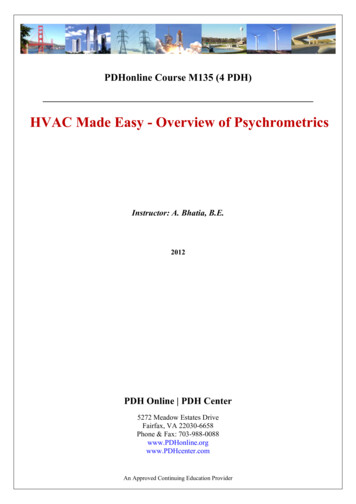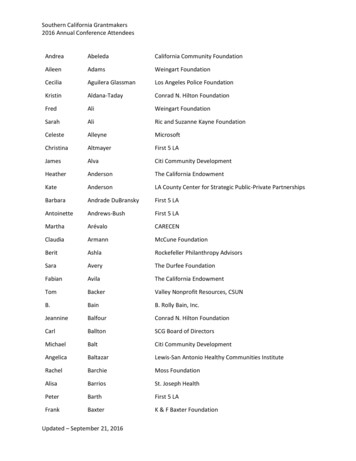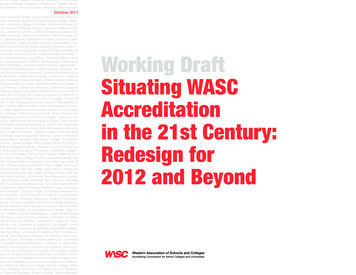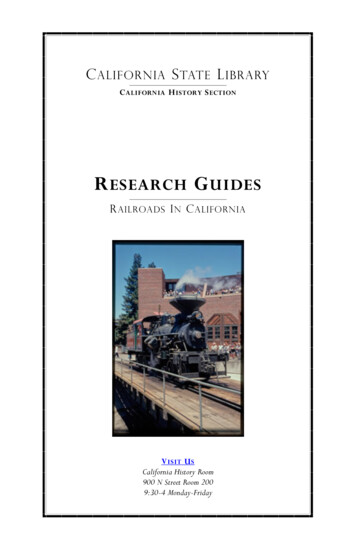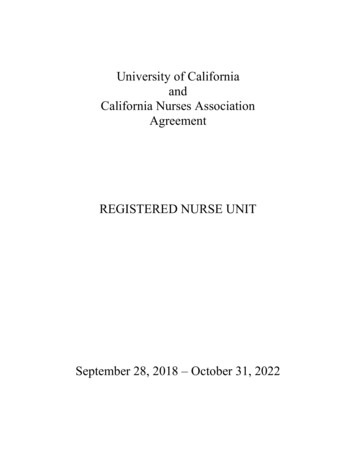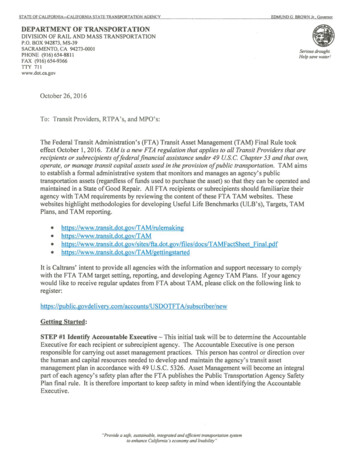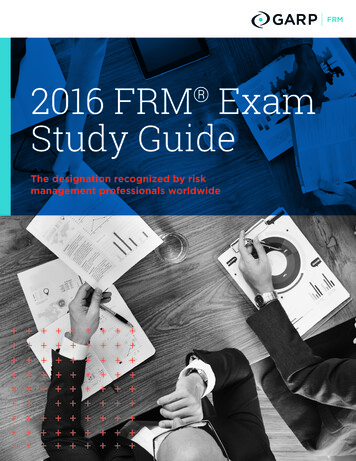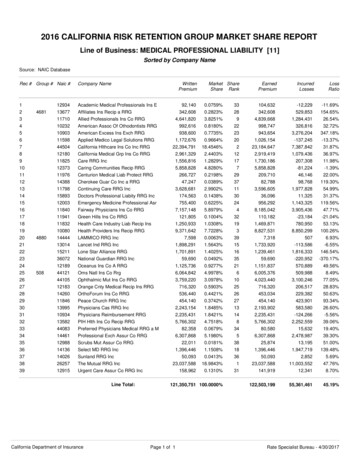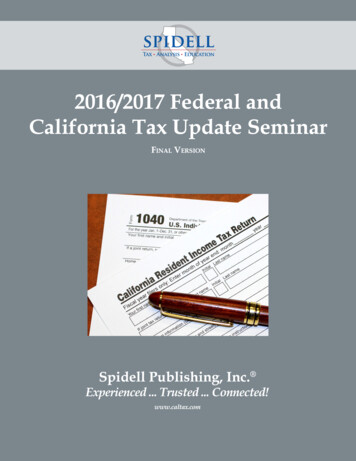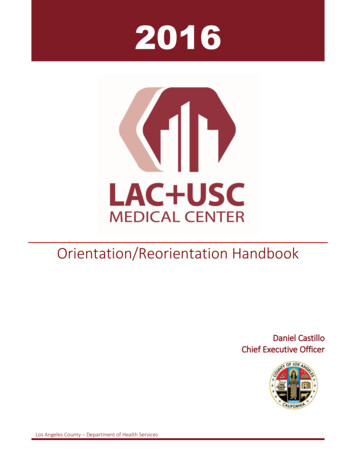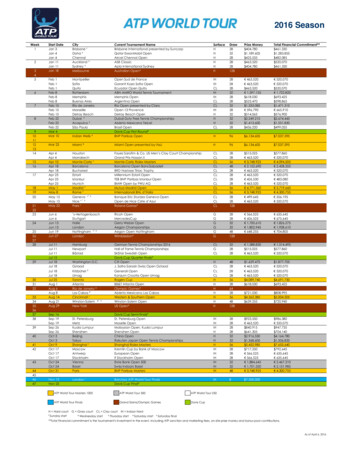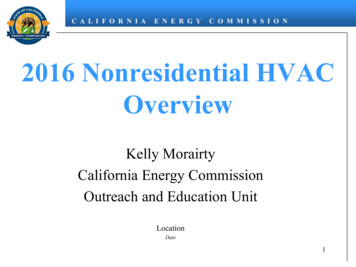
Transcription
C A L I F O R N I AE N E R G YC O M M I S S I O N2016 Nonresidential HVACOverviewKelly MorairtyCalifornia Energy CommissionOutreach and Education UnitLocationDate1
C A L I F O R N I AE N E R G YC O M M I S S I O NTodays Training Outline Training Goals Standards Background CEC History 2016 Standards overview Future energy and GHG goals Energy Standards Basics Mandatory requirements overview Compliance overview Nonresidential HVAC Meat andPotatoes Mandatory Requirements Prescriptive and PerformanceRequirements Additions and Alterations Enforcement Resources Navigating The Standards Demonstrating Compliance2
C A L I F O R N I AE N E R G YC O M M I S S I O NGoals for this Training Basic understanding of the following: Structure of the StandardsApplication of mandatory requirementsThe differences between prescriptive and performance complianceNonresidential mechanical forms General understanding of following: Mandatory requirements related to nonresidential HVAC Nonresidential HVAC prescriptive requirements3
C A L I F O R N I AE N E R G YC O M M I S S I O NQUESTIONS If you have questionsplease feel free to askat anytime: During class During breaks The end of class; or After class4
C A L I F O R N I AE N E R G YC O M M I S S I O NEnergy StandardsBackground5
C A L I F O R N I AE N E R G YC O M M I S S I O NA Little CEC History Our governing document is Section 25402 of the PublicResources Code also known as the Warren Alquist Act Signed into law in 1974 by Ronald Reagan and launched by JerryBrown in 1975 The act created the Energy Commission in 1974 and gave it authority todevelop and maintain Building Energy Efficiency Standards Mandates Building Efficiency Standards and requires the buildingdepartments to enforce them through the permit process Requires the Standards and new requirements to be cost effective overthe economic life of the structure Requires the Energy Commission to update the Standards periodically(about every 3 years)6
C A L I F O R N I AE N E R G YC O M M I S S I O N2016 Documents Building Energy EfficiencyStandards Reference Appendices Residential andNonresidential ComplianceManuals Alternative CalculationMethod (ACM) Manuals All docs. available online at:www.energy.ca.gov/title247
C A L I F O R N I AE N E R G YC O M M I S S I O NSummary of 2016 Major Changes Envelope U-factors Maximum values lowered Indoor and outdoor lighting Power allowances reduced Indoor lighting alterations Equipment efficiencies Minimum efficiencies increased(based on federal standards) HVAC Controls Door and window interlocks toturn HVAC off automatically Direct digital controls to thezone Covered Processes New requirements for elevatorsand escalators/movingwalkways8
C A L I F O R N I AE N E R G YC O M M I S S I O N2016 Nonresidential EnergySavings Overall, 5% more efficient than2013 Standards Electricity Savings 192 GWHs Demand Reduction 80 MW Gas Savings (0.9) Mtherms9
C A L I F O R N I AE N E R G YC O M M I S S I O N2016 Energy Savings10
C A L I F O R N I AE N E R G YC O M M I S S I O NWhat the Future Holds AB 32 – Reduces GHGs and carbon footprint SB 350 – Doubles efficiency and increases renewable energyto 50% CPUC/CEC Strategic Plan: ZNE goal for residential buildings by 2020 ZNE goal for nonresidential buildings by 2030Energy Standards will “evolve/expand” and become morestringent to reach these goals11
C A L I F O R N I AE N E R G YC O M M I S S I O NQUESTIONS About CEC or Standards?12
C A L I F O R N I AE N E R G YC O M M I S S I O NEnergy Standards Basics13
C A L I F O R N I AE N E R G YC O M M I S S I O NEnergy Standards Basics Topics Mandatory Measures Prescriptive Compliance Approach Performance Compliance Approach Navigating The Standards Structure of the code (Part 1 and Part 6) Navigation features in the electronic PDF. Demonstrating Compliance What type of forms are there When are they required Smart form features14
C A L I F O R N I AE N E R G YC O M M I S S I O NMandatory Measures Must always be met or exceeded Establish minimum level of energyefficiency and/or performance Apply to the different buildingcomponents Envelope Lighting Mechanical Sometimes are superseded by morestringent prescriptive requirements15
C A L I F O R N I AE N E R G YC O M M I S S I O NPrescriptive Measures Set of predefined efficiencyrequirements that must ALL be met orexceeded when using the prescriptivecompliance approach. Separate compliance for each “group”of building components. Simplest approach, but less flexible. Establishes baseline for the Standardbuilding budget under the PerformanceApproach.16
C A L I F O R N I AE N E R G YC O M M I S S I O NPerformance Compliance Also known as the computer method Requires the use of EnergyCommission approved software Most flexible approach, allows fortrade-offs Proposed Design TDV energy Standard Design TDV energy budget Modeling, budgets, assumptions, etc.located in the Nonresidential ACMReference Manual17
C A L I F O R N I AE N E R G YC O M M I S S I O NNavigating The Standards18
C A L I F O R N I AE N E R G YC O M M I S S I O NTITLE 24 - THE CALIFORNIABUILDING STANDARDS CODE Part 1 (Administrative Code) Chapter 10: the administrativerequirements Part 6 (Energy Code) Subchapters 1 through 9 Mostly referred to by Sectionnumbers These are the technicalrequirementsBSC Code Book19
C A L I F O R N I AE N E R G YC O M M I S S I O NTitle 24 Part 1, Chapter 10Section TitleSection #Section TitleSection Exemption10-10810-103Compliance Software, Alternative ComponentPackages, Exceptional Methods, DataRegistries and Data Input Software, AlternativeResidential Field Verification Protocols, andElectronic Document Repositories10-109Permit, Certificate, Informational, andEnforcement Requirements for Designers,Installers, Builders, Manufacturers, andSuppliersNonresidential Lighting Controls AcceptanceTest Training and Certification10-103.1Nonresidential Mechanical Acceptance TestTraining and Certification10-103.2Procedures for Consideration of ApplicationsUnder Sections 10-104, 10-106, 10-108, and10-109Certification and Labeling of FenestrationProduct U-Factors, Solar Heat Gain Coefficients,Visible Transmittance and Air Leakage10-11010-111Exceptional Designs10-104Criteria for Default Tables10-112Enforcement by the Commission10-105Certification and Labeling of Roofing ProductReflectance and Emittance10-113Locally Adopted Energy Standards10-106Determination of Outdoor Lighting Zones andAdministrative Rules for Use10-11420
C A L I F O R N I AE N E R G YC O M M I S S I O NTitle 24 Part 6SubchapterSubchapter TitleSections1All Occupancies - General Provisions§100.0 - §100.22All Occupancies - Mandatory Requirements for the Manufacture, Construction andInstallation of Systems, Equipment, and Building Components§110.0 - §110.113Nonresidential, High-Rise Residential, Hotel/Motel Occupancies and Covered Processes Mandatory Requirements§120.0 - §120.94Nonresidential, High-Rise Residential, Hotel/Motel Occupancies - Mandatory Requirementsfor Lighting Systems and Equipment, and Electrical Power Distribution Systems§130.0 - §130.55Nonresidential, High-Rise Residential, Hotel/Motel Occupancies - Performance andPrescriptive Compliance Approaches for Achieving Energy Efficiency§140.0 - §140.96Nonresidential, High-Rise Residential, Hotel/Motel Occupancies - Additions, Alterations,and Repairs§141.0 - §141.17Low-Rise Residential Buildings - Mandatory Features and Devices§150.08Low-Rise Residential Buildings - Performance and Prescriptive Compliance Approaches§150.19Low-Rise Residential Buildings - Additions and Alterations to Existing Low-RiseResidential Buildings§150.221
C A L I F O R N I AE N E R G YC O M M I S S I O NNavigation Features Easy Navigation Features Added Section and Table references hyperlinked throughout Energy Standards. TABLE 100.0-A separated with section hyperlinks. Chapter hyperlinks in Nonresidential Compliance Manual. Links work both online and in the downloaded version.22
C A L I F O R N I AE N E R G YC O M M I S S I O NDemonstrating Compliance23
C A L I F O R N I AE N E R G YC O M M I S S I O NHow To Demonstrate Compliance Compliance demonstration starts with compliancedocuments (forms). Completed by designers, consultants, builders, contractors, technicians,HERS raters, ATTs, etc. Submitted to enforcement agencies for verification at different stages ofconstruction. There are four form categories. Certificate of Compliance (NRCC) Certificate of Installation (NRCI) Certificate of Acceptance (NRCA) Certificate of Verification (NRCV) There are several sub-categories of each related to the buildingcomponent –MCH, ENV, LTI, etc.24
C A L I F O R N I AE N E R G YC O M M I S S I O NWhat is the NRCC? Nonresidential Certificate of Compliance Used to demonstrate compliance of the design. Completed by designer, architect, energy consultant,engineer, etc. Required with or on plans at permit. Plans Examiner verifies NRCC matches specs on plans.25
C A L I F O R N I AE N E R G YC O M M I S S I O NWhat is the NRCI? Nonresidential Certificate of Installation Confirms compliance at installation. Completed by builder or installing contractor. Required for Final Inspection. Field Inspector verifies installed equipment and efficienciesmeet design documentation (NRCC forms) and plans.26
C A L I F O R N I AE N E R G YC O M M I S S I O NWhat is the NRCA? Nonresidential Certificate of Acceptance Confirms compliance with acceptance testing requirements atinstallation (HVAC & Lighting). Completed by builder/installing contractor, OR an AcceptanceTest Technician (ATT) when required. Required for Final Inspection. Field Inspector verifies applicable tests and forms are completeand accurate.27
C A L I F O R N I AE N E R G YC O M M I S S I O NWhat is the NRCV? Nonresidential Certificate of Verification Confirms compliance with HERS testing requirements atinstallation (duct leakage & hot water piping). Completed by certified HERS rater, and forms must beregistered with an approved HERS Provider. Required for Final Inspection. Field Inspector verifies testing and forms are completed,signed, and registered.28
C A L I F O R N I AE N E R G YC O M M I S S I O NWhere can I find the forms?Appendix A of the 2016 Nonresidential Compliance CEC-400-2015-033/appendices/forms/
C A L I F O R N I AE N E R G YC O M M I S S I O NDynamic “Smart” Forms ALL 2016 NR forms are“dynamic” and “fillable” Some auto fill and conductsimple math calculations Interactive instructions Add and delete table rows30
C A L I F O R N I AE N E R G YC O M M I S S I O NNote about the Nonresidential DataRegistry All nonresidential forms are required to be registered(§10-103) Contingent upon approval of a nonresidential data registry. To date, no such registry has been approved. This means that registration is not required at this time. No application has been submitted as of yet to review.31
C A L I F O R N I AE N E R G YC O M M I S S I O NCode Quiz: What are the four types of forms and in what order are they typically used?1. NRCC – Certificate of Compliance.2. NRCI – Certificate of Installation.3. NRCA – Certificate of Acceptance4. NRCV – Certificate of Verification Which compliance approach offers the ability to trade off energy features?a) Performance Compliance Approachb) Prescriptive Compliance Approach Can you trade off mandatory measures for other higher efficiency featureswhen using the Performance Approach?a) Yesb) Noc) Maybe32
C A L I F O R N I AE N E R G YC O M M I S S I O NQUESTIONS About Compliance Approaches,Navigation?33
C A L I F O R N I AE N E R G YC O M M I S S I O NThe Meat and Potatoes ofNonresidential HVAC34
C A L I F O R N I AE N E R G YC O M M I S S I O NTitle 24 Part 6SubchapterSubchapter TitleSections1All Occupancies - General Provisions§100.0 - §100.22All Occupancies - Mandatory Requirements for the Manufacture, Construction andInstallation of Systems, Equipment, and Building Components§110.0 - §110.113Nonresidential, High-Rise Residential, Hotel/Motel Occupancies and Covered Processes Mandatory Requirements§120.0 - §120.94Nonresidential, High-Rise Residential, Hotel/Motel Occupancies - Mandatory Requirementsfor Lighting Systems and Equipment, and Electrical Power Distribution Systems§130.0 - §130.55Nonresidential, High-Rise Residential, Hotel/Motel Occupancies - Performance andPrescriptive Compliance Approaches for Achieving Energy Efficiency§140.0 - §140.96Nonresidential, High-Rise Residential, Hotel/Motel Occupancies - Additions, Alterations,and Repairs§141.0 - §141.17Low-Rise Residential Buildings - Mandatory Features and Devices§150.08Low-Rise Residential Buildings - Performance and Prescriptive Compliance Approaches§150.19Low-Rise Residential Buildings - Additions and Alterations to Existing Low-RiseResidential Buildings§150.235
C A L I F O R N I ASubchapter Title2All Occupancies Mandatory Requirementsfor Systems and Equipment56C O M M I S S I O NPart 6 Nonresidential HVAC SectionsSubchapter3E N E R G YNonresidential, High-RiseResidential, Hotel/MotelOccupancies and CoveredProcesses - MandatoryRequirementsNonresidential, High-RiseResidential, Hotel/MotelOccupancies Performance andPrescriptive ComplianceNonresidential, High-RiseResidential, Hotel/MotelOccupancies - Additions,Alterations, and RepairsSectionSection Title§110.1Mandatory requirements for Appliances§110.2Mandatory requirements for Space-Conditioning Equipment§110.5Pilot Lights Prohibited§120.1Requirements for Ventilation§120.2Required Controls for Space-Conditioning Systems§120.3Requirements for Pipe Insulation§120.4Requirements for Air Distribution Systems, Ducts and Plenums§120.5Required Nonresidential Mechanical System Acceptance§120.8Nonresidential Building Commissioning§120.9Mandatory Requirements for Commercial Boilers§140.1Performance Approach: Energy Budget§140.2Prescriptive Approach§140.4Prescriptive Requirements for Space Conditioning Systems§141.0Additions, Alterations, and Repairs to Existing Nonresidential, HighRise Residential, and Hotel/Motel Buildings36
C A L I F O R N I AE N E R G YC O M M I S S I O NSubchapter 2All OccupanciesMandatory Requirementsfor the Manufacture, Construction andInstallation of Systems, Equipment andBuilding Components(Sections §110.0 -§110.11)37
C A L I F O R N I AE N E R G YC O M M I S S I O N§110 SeriesAll Occupancies Mandatory HVAC Requirements §110.1 - Mandatory Requirements for Appliances §110.2 - Mandatory Requirements for Space ConditioningEquipment §110.5 - Natural Gas Central Furnaces, Cooking Equipment,and Pool and Spa Heaters: Pilot Lights Prohibited38
C A L I F O R N I AE N E R G YC O M M I S S I O N§110.1 – Mandatory Requirements forAppliances39
C A L I F O R N I AE N E R G YC O M M I S S I O N§110.1 – Mandatory Requirements for Appliances Systems, equipment and appliances may be installed only ifthey are certified and listed as follows: If the item is covered by Title 20, it must meet the Title 20 efficiencyrequirements and be listed in the Title 20 database (MAEDBS). Items having efficiency requirements in Title 24, Part 6 must be listed inone of the following: Title 20 database Federal database Approved trade association database such as AHRI or CTI If the equipment cannot be listed, you must demonstrate efficiencyconformance per the procedures outlined in Section 10-109 of Part 1.40
C A L I F O R N I AE N E R G YC O M M I S S I O N§110.2 - Mandatory Requirements forSpace Conditioning Equipment41
C A L I F O R N I AE N E R G YC O M M I S S I O N§110.2 - Mandatory Requirements for SpaceConditioning Equipment All equipment covered in thissection must be certified bythe manufacturer. (a) All equipment listed inTABLE 110.2-A through TABLE110.2-K must meet the applicableefficiencies when tested per thelisted test procedure. EXCEPTION: There are exceptions for some water chilling packages, some positivedisplacement chillers and equipment serving refrigerated warehouses orcommercial refrigeration. See §110.2(a) for details.42
C A L I F O R N I AE N E R G YC O M M I S S I O N§110.2 - Mandatory Requirements for SpaceConditioning Equipment (b) Heat pumps withsupplementary electric resistanceheaters must have controls that: Prevent supplementary heateroperation when the heating loadcan be met by the heat pumpalone. The cut-on and cut-offtemperatures for the electricresistance heating must be lowerthan the heat pump cut-on andcut-off temperatures. EXCEPTION: There are exceptions for defrost, transient periods, and room airconditioners.43
C A L I F O R N I AE N E R G YC O M M I S S I O N§110.2 - Mandatory Requirements for SpaceConditioning Equipment (c) Thermostat Requirements All unitary systems without an EMCS must have a setback thermostat thatcan be programed with at least four temperature setpoints within 24 hours. Thermostats for heat pumps must also control supplementary electricresistance heaters as discussed on the previous slide. EXCEPTION: Gravity gas wall heaters, gravity floorheaters, gravity room heaters, noncentral electric heaters, fireplaces ordecorative gas appliances, woodstoves, room air conditioners, androom air-conditioner heat pumps arenot required have to have setbackthermostats.44
C A L I F O R N I AE N E R G YC O M M I S S I O N§110.2 - Mandatory Requirements for SpaceConditioning Equipment (d) Gas- and Oil-Fired Furnace 225,000 Btu/h must have controls tolimit Standby Loss: They must have an intermittent ignition or interrupt device (IID). They must have either power venting or a flue damper. A vent damper is permissible with furnaces using combustion air from theconditioned space. All furnaces not located within the conditioned space must have jacket heatlosses not exceeding 0.75 percent of the input rating.45
C A L I F O R N I AE N E R G YC O M M I S S I O N§110.2 - Mandatory Requirements for SpaceConditioning Equipment Cooling towers46
C A L I F O R N I AE N E R G YC O M M I S S I O N§110.2 - Mandatory Requirements for SpaceConditioning Equipment Cooling towers typesOPEN CYCLECLOSED CYCLE47
C A L I F O R N I AE N E R G YC O M M I S S I O N§110.2 - Mandatory Requirements for SpaceConditioning Equipment (e) Cooling towers 150 tons must have the following: Conductivity or Flow-based controls that maximize cycles of concentration basedon local water quality and an approved calculator using a Langelier SaturationIndex (LSI) of 2.5 or less. The NRCC-MCH-06 form is used to document this and must be signed by theProfessional Engineer (P.E.) of Record. Have a flow meter with an analog output for flow either hardwired or availablethrough a gateway on the makeup water line and have an overflow alarm. They must be equipped with Drift Eliminators that achieve drift reduction to 0.002percent of the circulated water volume for counter-flow towers and 0.005 percentfor cross-flow towers. Nonresidential Manual chapter 4.6.1.1 is a good resource for cooling tower waterconservation information.48
C A L I F O R N I AE N E R G YC O M M I S S I O N§110.2 – Mandatory Requirements for SpaceConditioning Equipment (f) Low leakage air handler compliance credit: The air handler must be listed on the Energy Commission’s list of certifiedproducts. After installation, the system and attached ducts must be leak tested by aHERS rater and the documentation uploaded to the HERS Registry. Credit is only available if the performance method is used.49
C A L I F O R N I AE N E R G YC O M M I S S I O N§110.5 - Natural Gas Central Furnaces,Cooking Equipment, and Pool and SpaHeaters: Pilot Lights Prohibited50
C A
installation (HVAC & Lighting). Completed by builder/installing contractor, OR an Acceptance Test Technician (ATT) when required. Required for Final Inspection. Field Inspector verifies applicable tests
